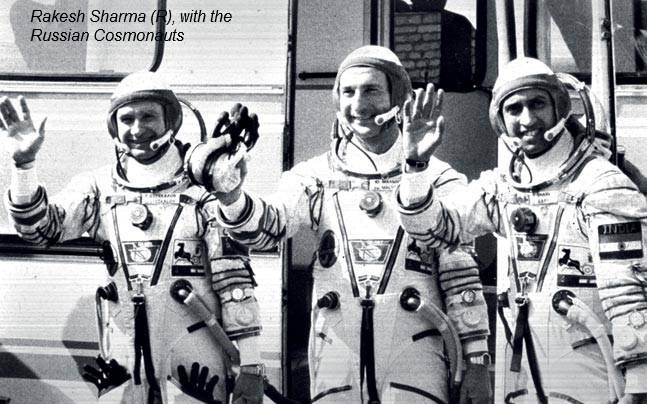Astronautics: India
(→Rakesh Sharma: India’s first space traveler so far) |
(→Rakesh Sharma: India’s first space traveler so far) |
||
| Line 60: | Line 60: | ||
[http://indiatoday.intoday.in/story/india-today-41st-anniversary-science-technology-progress/1/834949.html India Today.in , Our man in space “India Today” 15/12/2016] | [http://indiatoday.intoday.in/story/india-today-41st-anniversary-science-technology-progress/1/834949.html India Today.in , Our man in space “India Today” 15/12/2016] | ||
| − | [[File: India | + | [[File: India Today , December 15,2016.jpg | India Today , December 15,2016.jpg |frame|500px]] |
1984 | 1984 | ||
Latest revision as of 17:40, 28 July 2017
This is a collection of articles archived for the excellence of their content. |
[edit] 10 space age moments
India Today, December 19, 2008
Amarnath K. Menon
1. WE HAVE LIFT-OFF 1975
The first Indian satellite Aryabhatta is launched by the Soviet Union from Kapustin Yar using a Kosmos—3M launch vehicle on April 19, 1975. Its aim is to provide an opportunity to conduct investigations in space sciences. It carries three experiments, one each in X-ray astronomy, solar physics and aeronomy.
2. SCREENING FOR ALL 1975
The Satellite Instructional Television Experiment begins on August 1, 1975, when 2,400 black and white community TV sets come alive in as many as villages in clusters across six states long before urban India experiences TV. NASA and ISRO join hands to design and implement this ambitious project.
3. SENSING IT RIGHT 1979
ISRO launches Bhaskara-1, a 444-kg experimental remote-sensing satellite for earth observations on June 7, 1979, from another Soviet Kosmos. The mission conducts earth observation experiments for applications related to hydrology and geology.
4. STELLAR HONOUR 1979
Astronomer R.M.West discovers a main belt asteroid and names it Vainu Bappu—father of modern Indian astrophysics. His discovery of an important phenomenon in stellar chromospheres is known to researchers in astronomy as the Wilson-Bappu Effect.
5. A LAUNCHER OF OUR OWN 1980
On July 18, 1980, India preens with pride as it joins the exclusive club of space powers that can lob a satellite with a homemade rocket from their own soil. The second experimental Satellite Launch Vehicle (SLV-3) places the Rohini Satellite (RS-D1) in orbit almost a year after the first attempt failed in 1979.
6. COMMUNICATION LEAP 1982
India’s first indigenous communication satellite, Indian National Satellite (INSAT-1 A), is launched by the US Delta rocket on April 10, 1982.
7. MAN IN SPACE 1984
On April 2, 1984, the first and only Indian space traveller so far, Rakesh Sharma, is shot up into space to spend eight days aboard the Salyut 7 with two Soviet cosmonauts.
8. IF AK FIRST... 1994
The Polar Satellite Launch Vehicle is launched, using solid and liquid propulsive systems alternately, on October 15, 1994, after the failure of the first attempt.
9. TENACITY WINS 2003
The second flight of the Geostationary Satellite Launch Vehicle on May 8,2003 proves India can place a communications satellite into geosynchronous orbit after the first attempt in 2001.
10. MOON MAGIC 2008
India’s space programme comes of age as the first unmanned space mission Chandrayaan-1 reaches the moon. It includes a lunar orbiter and an impactor launched by a modified version of the PSLV on October 22, 2008 and inserted into lunar orbit on November 8, 2008.
[edit] Rakesh Sharma: India’s first space traveler so far
India Today.in , Our man in space “India Today” 15/12/2016
1984
Rakesh Sharma
Our man in space
Saare jahan se acchha" is how Rakesh Sharma, the first Indian space traveler (and the only one so far), described how India looked from space. The squadron leader and test pilot with the Indian Air Force was speaking at the time to then prime minister Indira Gandhi, after spending eight days aboard the Salyut 7 space station along with two Soviet cosmonauts. They had departed on April 2, in a Soyuz T-11 spacecraft. The joint ISRO-Soviet Intercosmos space programme had reached a new high with this manned space mission. During the flight, Sharma performed multi-spectral photography of northern India, in anticipation of the construction of hydro-electric power stations in the Himalayas. Sharma spent almost eight days in space, during which time he carried out scientific and technical studies, mostly in the fields of biomedicine and remote sensing. On his return, Sharma and the two Russian cosmonauts were conferred the Ashoka Chakra-the highest gallantry award during peace time-as well as being honoured with the Hero of Soviet Union award.
